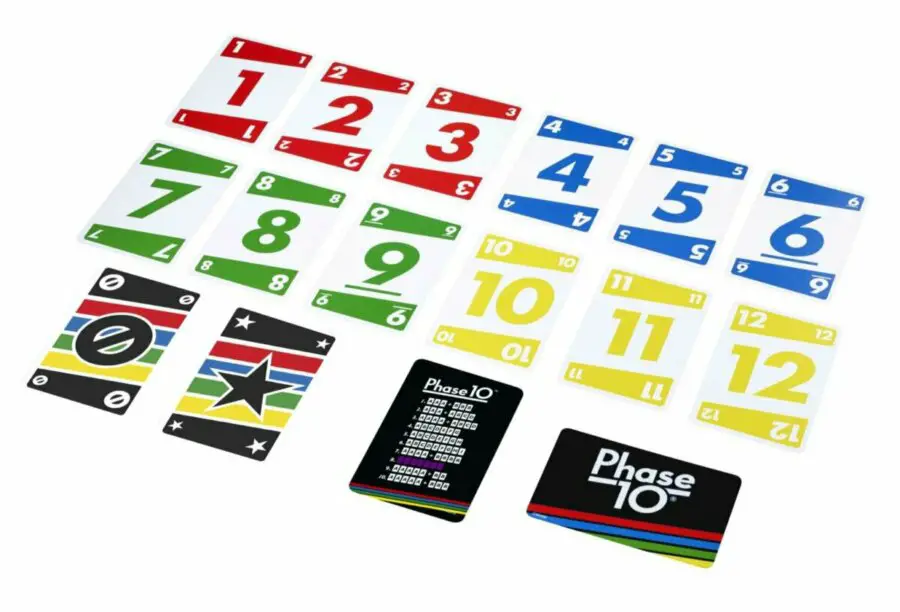Phase 10 can be played by 2 to 6 players and is suitable for ages 7 and up, making it a great choice for family game nights.
Since its invention in 1982 by Kenneth Johnson, the game has become a household favourite in many countries, earning its place among classics like Uno and Rummy.
Whether you’re a seasoned pro or just discovering this engaging game, this post will provide you with everything you need to understand how to play Phase 10, grasp the rules, and uncover clever strategies to take your game to the next level.
Table of Contents
Phase 10 Components and Game Setup
Phase 10 is a game that’s as easy to set up as it is fun to play. Let’s take a look at what you’ll need and how to prepare for a game.
What’s Included in the Box
- A deck of 108 cards, consisting of numbered cards from 1 to 12 in four colours, and special ‘Wild’ and ‘Skip’ cards.
- Phase 10 Reference Cards to help players keep track of the 10 phases.
- A scorepad to note scores.
How to Set Up the Game
- Shuffle the deck and deal 10 cards to each player, face-down.
- Place the remaining deck in the centre as a draw pile, and turn the top card over to start the discard pile.
- Choose a player to go first (commonly the youngest player, but feel free to choose your own method).
- Give each player a reference card, and make sure everyone is clear on the 10 phases they’ll be trying to complete.
How to Play: Phase 10
Understanding how to play Phase 10 is key to enjoying this captivating card game. Here’s a breakdown of what you need to know to jump right into the action.
Objective of the Game
The goal of Phase 10 is to be the first player to complete all 10 phases. A phase is a combination of cards, and each phase must be completed in order to move on to the next one. Fail to complete a phase, and you’ll find yourself repeating it in the next round.
The Structure of a Turn
A player’s turn consists of three main steps:
- Draw: Pick up a card from either the draw pile or the discard pile.
- Lay Down a Phase (if possible): If you have the right cards to complete your current phase, lay them down.
- Discard: End your turn by discarding a card onto the discard pile.
Explanation of Phases
Each of the 10 phases requires a specific combination of cards, such as a set and/or a run.
- A set means cards of the same number, e.g. 3x 8’s would be a set of 3.
- A run means consecutive numbers, e.g. 2, 3, 4 and 5 would be a run of four.
The full list of phase in a game of Phase 10 are as follows:
- Two sets of three
- One set of three and one run of four
- One set of four and one run of four
- One run of seven
- One run of eight
- One run of nine
- Two sets of four
- Seven cards of one colour
- One set of five and one set of two
- One set of five and one set of three
How to Complete a Phase
To complete a phase, you must have the required cards and lay them down during your turn. Once a phase is complete, you work on the next phase in the following round. If you don’t complete the phase, you must try again in the next round.
The game continues in rounds until one player has completed all 10 phases. The player who does this first is the winner, but scoring can determine the overall champion, especially in multiple games.
This basic structure is at the heart of Phase 10, providing endless entertainment and strategic opportunities. Up next, we’ll delve into the rules to make sure you’ve got a firm grip on how everything works.
Phase 10 Gameplay Rules
Now that you have a handle on how to play Phase 10, let’s delve into the rules to ensure a smooth and enjoyable gaming experience.
Basic Rules Overview
- Players take turns in a clockwise direction.
- If you pick up a card from the discard pile during your turn, you must use it in your phase for that round.
- After laying down a phase, you can “hit” on other players’ laid-down phases if you have a card that fits (but only if you’ve laid down your phase for the round).
- The round ends when a player discards their last card.
Special Rules and Variations
- Wild Cards: These can be used as any number or colour to help complete a phase.
- Skip Cards: Play a skip card to force another player to lose their turn.
- Scoring: At the end of each round, players score points based on the cards left in their hand. Completing phases also contributes to the score.
- Multiple Game Variations: Phase 10 allows for various house rules and game modifications, so feel free to mix things up according to your preferences.
The rules of Phase 10 are simple enough for new players to grasp quickly, but they offer enough depth to keep even seasoned card game veterans engaged. It’s a delicate balance that has helped make Phase 10 a favourite for players of all ages.
Strategies and Tips for Phase 10
Winning in Phase 10 isn’t solely about luck; applying the right strategies and tips can turn you into a formidable opponent. Whether you’re a newcomer or an experienced player, here’s how you can up your game:
Beginner Strategies
- Know Your Phases: Familiarise yourself with the 10 phases so you can plan ahead.
- Use Wild Cards Wisely: Don’t use them early on a phase you are likely to complete easily. Save them for trickier phases.
Intermediate Strategies
- Watch Your Opponents: Keep an eye on what others are discarding and picking up. It can give you clues about their phases and strategy.
- Manage Your Hand: Try to keep a balance in your hand that can be flexible for current and future phases.
Expert Tips and Tricks
- Mind the Skip Cards: Use Skip cards strategically to slow down players who are ahead.
- Think Ahead: If you’re close to completing a phase, start planning for the next one.
- Scoring Considerations: Sometimes, it may be beneficial to stay in a phase if you can score more by hitting on others.
Frequently Asked Questions
What happens if no one completes a phase in a round of Phase 10?
If no one completes their phase in a round, all players continue working on their current phase in the next round.
Can you replace a Wild Card once it’s been laid down in Phase 10?
No, once a Wild Card has been used in a phase, it cannot be replaced or moved to another phase.
How do you handle a tie at the end of a Phase 10 game?
If two or more players complete the 10th phase in the same round, the player with the lowest score wins.
Can you create custom phases in Phase 10?
Absolutely! Many players enjoy creating their own custom phases to add a unique twist to the game. Just make sure all players agree on the custom phases before starting.
Is there an official Phase 10 app or online version?
Yes, there are official Phase 10 apps available on various platforms, allowing you to enjoy the game digitally with friends or against AI opponents.
Conclusion
Phase 10 is a game that offers endless enjoyment, blending luck, skill, and strategy.
Whether you’re a beginner or an old hand, there’s always something new to explore and master. Now that you’re armed with all the knowledge you need, why not dive into a game?
And don’t forget to share your strategies and tips for playing Phase 10 in the comments below!

Avid game player with a competitive personality. Favourite board games include Ticket to Ride, Catan, Cambio and President. Find me on Xbox Live here.
Read the About page to find more about Tiny Monkey Games.
